engine oil Lancia Ypsilon 2020 Owner handbook (in English)
[x] Cancel search | Manufacturer: LANCIA, Model Year: 2020, Model line: Ypsilon, Model: Lancia Ypsilon 2020Pages: 200, PDF Size: 4.53 MB
Page 45 of 200
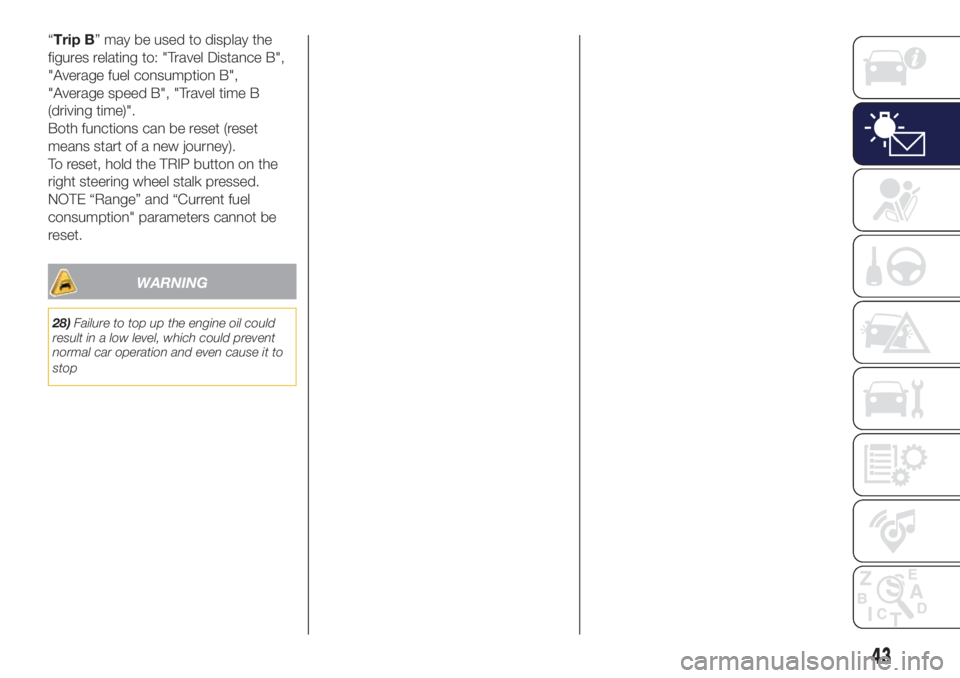
“Trip B” may be used to display the
figures relating to: "Travel Distance B",
"Average fuel consumption B",
"Average speed B", "Travel time B
(driving time)".
Both functions can be reset (reset
means start of a new journey).
To reset, hold the TRIP button on the
right steering wheel stalk pressed.
NOTE “Range” and “Current fuel
consumption" parameters cannot be
reset.
WARNING
28)Failure to top up the engine oil could
result in a low level, which could prevent
normal car operation and even cause it to
stop
43
Page 50 of 200
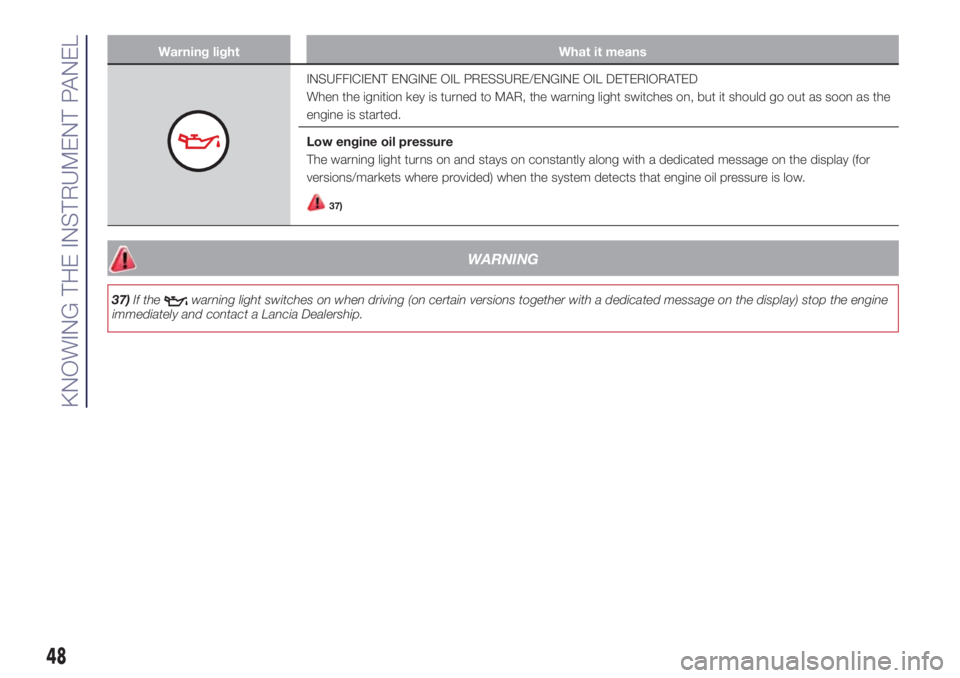
Warning light What it means
INSUFFICIENT ENGINE OIL PRESSURE/ENGINE OIL DETERIORATED
When the ignition key is turned to MAR, the warning light switches on, but it should go out as soon as the
engine is started.
Low engine oil pressure
The warning light turns on and stays on constantly along with a dedicated message on the display (for
versions/markets where provided) when the system detects that engine oil pressure is low.
37)
WARNING
37)If thewarning light switches on when driving (on certain versions together with a dedicated message on the display) stop the engine
immediately and contact a Lancia Dealership.
48
KNOWING THE INSTRUMENT PANEL
Page 51 of 200
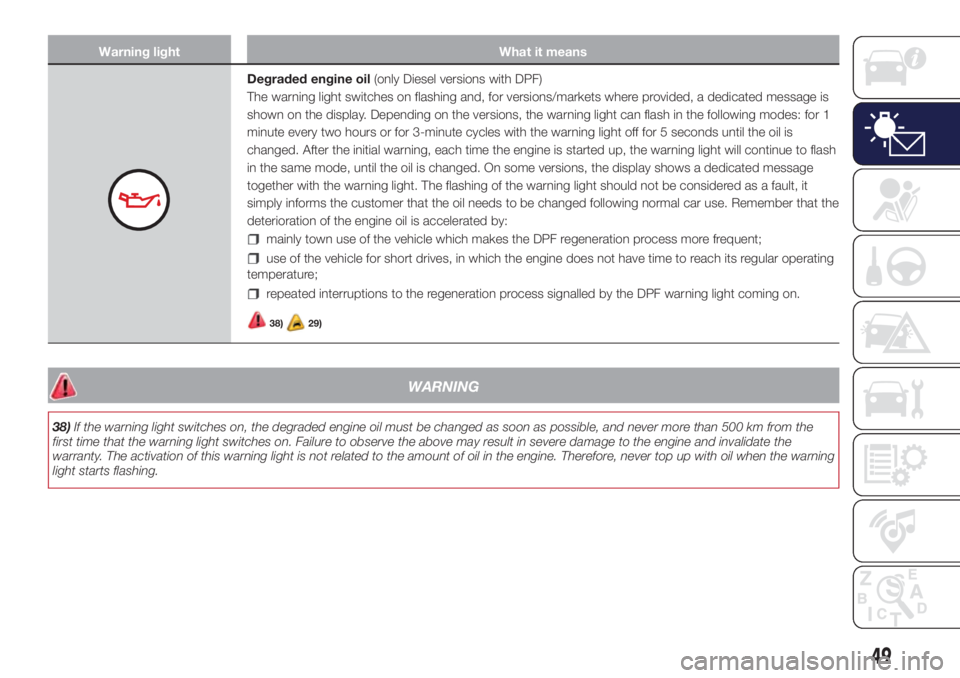
Warning light What it means
Degraded engine oil(only Diesel versions with DPF)
The warning light switches on flashing and, for versions/markets where provided, a dedicated message is
shown on the display. Depending on the versions, the warning light can flash in the following modes: for 1
minute every two hours or for 3-minute cycles with the warning light off for 5 seconds until the oil is
changed. After the initial warning, each time the engine is started up, the warning light will continue to flash
in the same mode, until the oil is changed. On some versions, the display shows a dedicated message
together with the warning light. The flashing of the warning light should not be considered as a fault, it
simply informs the customer that the oil needs to be changed following normal car use. Remember that the
deterioration of the engine oil is accelerated by:
mainly town use of the vehicle which makes the DPF regeneration process more frequent;
use of the vehicle for short drives, in which the engine does not have time to reach its regular operating
temperature;
repeated interruptions to the regeneration process signalled by the DPF warning light coming on.
38)29)
WARNING
38)If the warning light switches on, the degraded engine oil must be changed as soon as possible, and never more than 500 km from the
first time that the warning light switches on. Failure to observe the above may result in severe damage to the engine and invalidate the
warranty. The activation of this warning light is not related to the amount of oil in the engine. Therefore, never top up with oil when the warning
light starts flashing.
49
Page 52 of 200
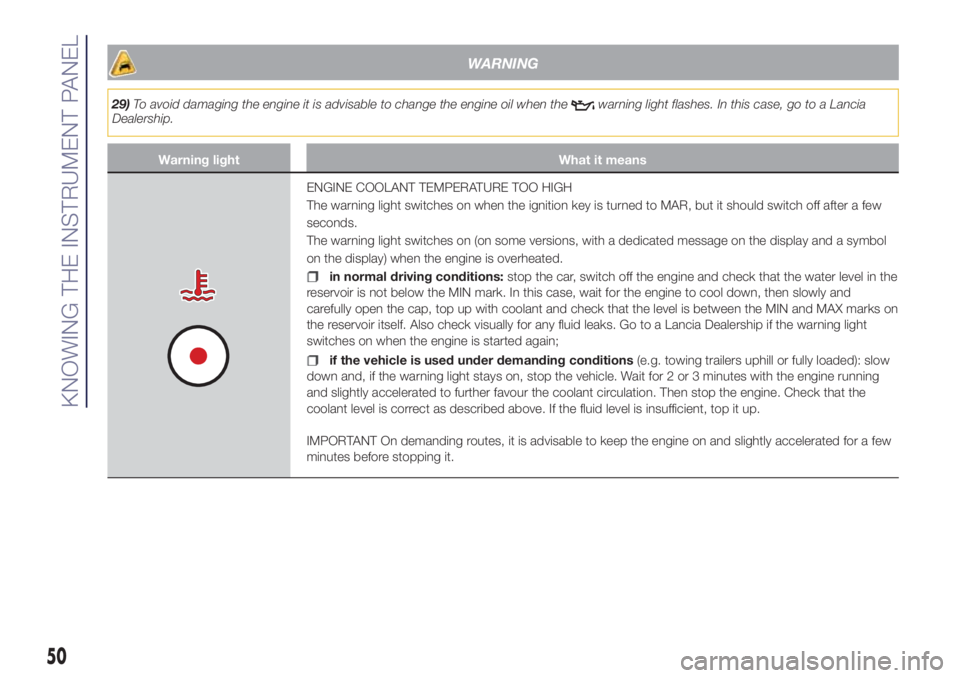
WARNING
29)To avoid damaging the engine it is advisable to change the engine oil when thewarning light flashes. In this case, go to a Lancia
Dealership.
Warning light What it means
ENGINE COOLANT TEMPERATURE TOO HIGH
The warning light switches on when the ignition key is turned to MAR, but it should switch off after a few
seconds.
The warning light switches on (on some versions, with a dedicated message on the display and a symbol
on the display) when the engine is overheated.
in normal driving conditions:stop the car, switch off the engine and check that the water level in the
reservoir is not below the MIN mark. In this case, wait for the engine to cool down, then slowly and
carefully open the cap, top up with coolant and check that the level is between the MIN and MAX marks on
the reservoir itself. Also check visually for any fluid leaks. Go to a Lancia Dealership if the warning light
switches on when the engine is started again;
if the vehicle is used under demanding conditions(e.g. towing trailers uphill or fully loaded): slow
down and, if the warning light stays on, stop the vehicle. Wait for 2 or 3 minutes with the engine running
and slightly accelerated to further favour the coolant circulation. Then stop the engine. Check that the
coolant level is correct as described above. If the fluid level is insufficient, top it up.
IMPORTANT On demanding routes, it is advisable to keep the engine on and slightly accelerated for a few
minutes before stopping it.
50
KNOWING THE INSTRUMENT PANEL
Page 58 of 200

Warning light What it means
DPF (PARTICULATE FILTER) CLEANING IN PROGRESS (Diesel versions with DPF)
The warning light switches on when the ignition key is turned to MAR, but it should switch off after a few
seconds.
The warning light (together with a dedicated message and a symbol on the display on some versions)
switches on constantly to notify the driver that the DPF system needs to eliminate captured pollutants
(particulate) through the regeneration process.
The warning light does not come on during every DPF regeneration, but only when driving conditions
require that the driver is notified. To switch the warning light off, the vehicle must be kept moving until the
regeneration process is completed. On average, the process lasts 15 minutes. Optimal conditions for
completing the process are achieved by travelling at 60 km/h with engine speed above 2000 rpm.
When this warning light switches on, it does not indicate a vehicle failure and thus it should not be taken to
a workshop. On some versions, together with the warning light switching on, the display shows a
dedicated message.
40)
WARNING
40)Vehicle travel speed should always be adapted to the traffic and weather conditions, and must always comply with traffic regulations. The
engine can be stopped even if the DPF warning light is on: however, repeated interruptions of the regeneration process could cause
premature deterioration of the engine oil. For this reason, it is always advisable to wait for the warning light to go off before turning the engine
off, following the instructions appearing above. Do not complete the DPF regeneration process when the vehicle is stopped.
56
KNOWING THE INSTRUMENT PANEL
Page 60 of 200

Warning light What it means
Parking sensor fault(for versions/markets where provided)
The warning light (or symbol for versions with multifunction reconfigurable display) switches on together
with a dedicated message on the display, when a parking sensors fault is detected.
Dusk sensor fault(for versions/markets where provided)
The warning light (or symbol for versions with multifunction reconfigurable display) switches on together
with a dedicated message on the display, when a dusk sensor fault is detected.
Engine oil pressure sensor failure
The engine oil pressure sensor fault is signalled by the warning light (or symbol for versions with
reconfigurable multifunction display) on the instrument panel that switches on.
Airbag warning light fault(for versions/markets where provided)
The warning light (or symbol for versions with multifunction reconfigurable display) switches on flashing
when a fault is detected on the
warning light.
Tyre pressure monitoring system (iTPMS) not available
The warning light (or symbol for versions with multifunction reconfigurable display) switches on together
with a dedicated message on the display, to indicate that the tyre pressure monitoring system (iTPMS) is
not available.
58
KNOWING THE INSTRUMENT PANEL
Page 130 of 200
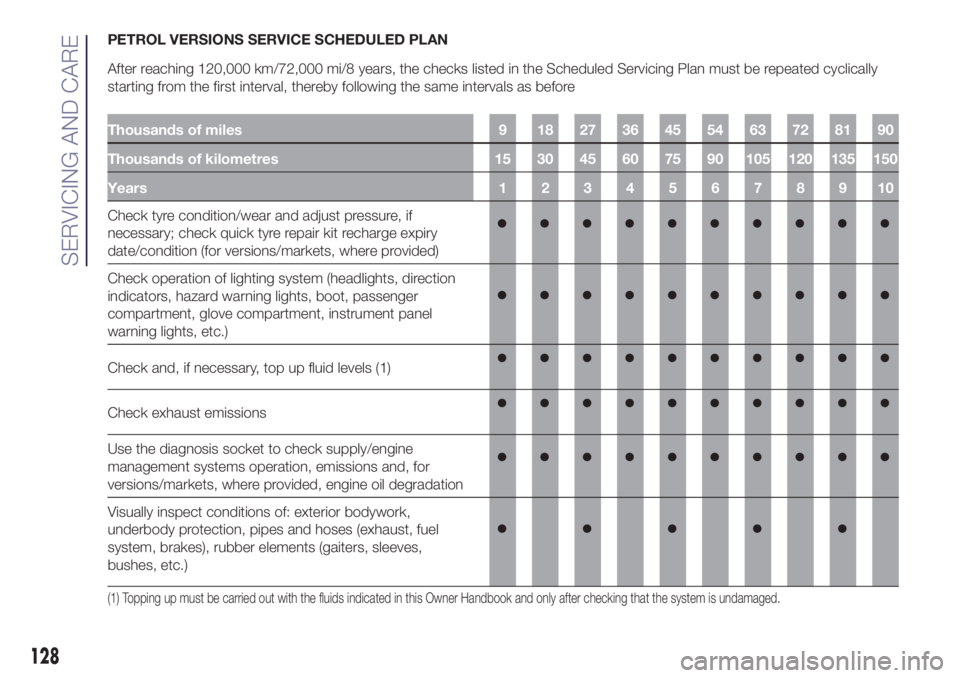
PETROL VERSIONS SERVICE SCHEDULED PLAN
After reaching 120,000 km/72,000 mi/8 years, the checks listed in the Scheduled Servicing Plan must be repeated cyclically
starting from the first interval, thereby following the same intervals as before
Thousands of miles 9 18 27 36 45 54 63 72 81 90
Thousands of kilometres 15 30 45 60 75 90 105 120 135 150
Years12345678910
Check tyre condition/wear and adjust pressure, if
necessary; check quick tyre repair kit recharge expiry
date/condition (for versions/markets, where provided)
Check operation of lighting system (headlights, direction
indicators, hazard warning lights, boot, passenger
compartment, glove compartment, instrument panel
warning lights, etc.)
Check and, if necessary, top up fluid levels (1)
Check exhaust emissions
Use the diagnosis socket to check supply/engine
management systems operation, emissions and, for
versions/markets, where provided, engine oil degradation
Visually inspect conditions of: exterior bodywork,
underbody protection, pipes and hoses (exhaust, fuel
system, brakes), rubber elements (gaiters, sleeves,
bushes, etc.)
(1) Topping up must be carried out with the fluids indicated in this Owner Handbook and only after checking that the system is undamaged.
128
SERVICING AND CARE
Page 133 of 200
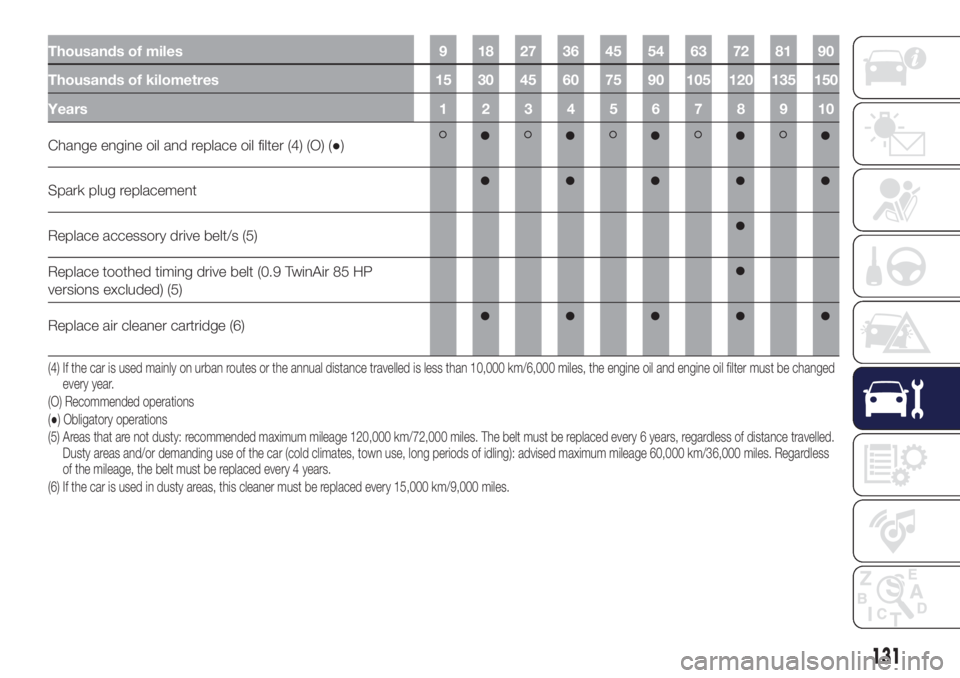
Thousands of miles 9 18 27 36 45 54 63 72 81 90
Thousands of kilometres 15 30 45 60 75 90 105 120 135 150
Years12345678910
Change engine oil and replace oil filter (4) (O) (●)
Spark plug replacement
Replace accessory drive belt/s (5)
Replace toothed timing drive belt (0.9 TwinAir 85 HP
versions excluded) (5)
Replace air cleaner cartridge (6)
(4) If the car is used mainly on urban routes or the annual distance travelled is less than 10,000 km/6,000 miles, the engine oil and engine oil filter must be changed
every year.
(O) Recommended operations
(●) Obligatory operations
(5) Areas that are not dusty: recommended maximum mileage 120,000 km/72,000 miles. The belt must be replaced every 6 years, regardless of distance travelled.
Dusty areas and/or demanding use of the car (cold climates, town use, long periods of idling): advised maximum mileage 60,000 km/36,000 miles. Regardless
of the mileage, the belt must be replaced every 4 years.
(6) If the car is used in dusty areas, this cleaner must be replaced every 15,000 km/9,000 miles.
131
Page 135 of 200
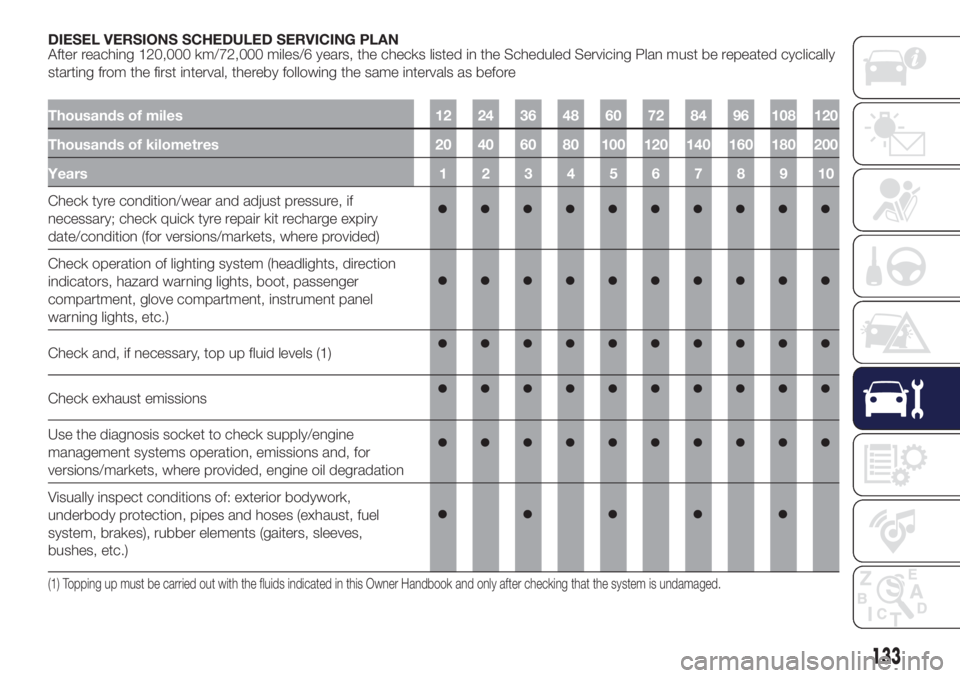
DIESEL VERSIONS SCHEDULED SERVICING PLAN
After reaching 120,000 km/72,000 miles/6 years, the checks listed in the Scheduled Servicing Plan must be repeated cyclically
starting from the first interval, thereby following the same intervals as before
Thousands of miles 12 24 36 48 60 72 84 96 108 120
Thousands of kilometres 20 40 60 80 100 120 140 160 180 200
Years12345678910
Check tyre condition/wear and adjust pressure, if
necessary; check quick tyre repair kit recharge expiry
date/condition (for versions/markets, where provided)
Check operation of lighting system (headlights, direction
indicators, hazard warning lights, boot, passenger
compartment, glove compartment, instrument panel
warning lights, etc.)
Check and, if necessary, top up fluid levels (1)
Check exhaust emissions
Use the diagnosis socket to check supply/engine
management systems operation, emissions and, for
versions/markets, where provided, engine oil degradation
Visually inspect conditions of: exterior bodywork,
underbody protection, pipes and hoses (exhaust, fuel
system, brakes), rubber elements (gaiters, sleeves,
bushes, etc.)
(1) Topping up must be carried out with the fluids indicated in this Owner Handbook and only after checking that the system is undamaged.
133
Page 137 of 200
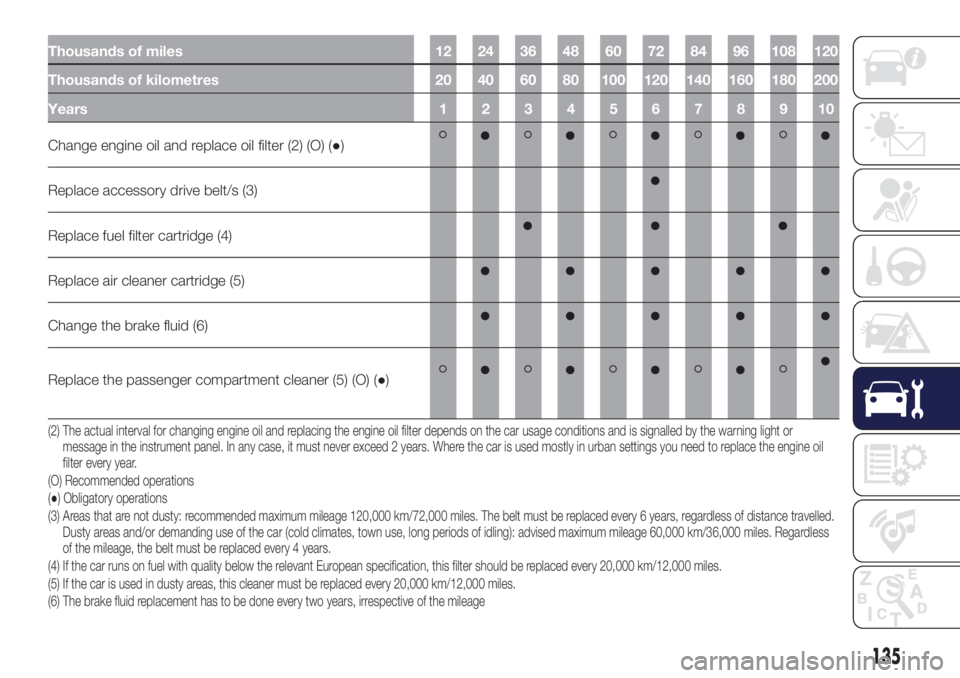
Thousands of miles 12 24 36 48 60 72 84 96 108 120
Thousands of kilometres 20 40 60 80 100 120 140 160 180 200
Years12345678910
Change engine oil and replace oil filter (2) (O) (●)
Replace accessory drive belt/s (3)
Replace fuel filter cartridge (4)
Replace air cleaner cartridge (5)
Change the brake fluid (6)
Replace the passenger compartment cleaner (5) (O) (●)
(2) The actual interval for changing engine oil and replacing the engine oil filter depends on the car usage conditions and is signalled by the warning light or
message in the instrument panel. In any case, it must never exceed 2 years. Where the car is used mostly in urban settings you need to replace the engine oil
filter every year.
(O) Recommended operations
(●) Obligatory operations
(3) Areas that are not dusty: recommended maximum mileage 120,000 km/72,000 miles. The belt must be replaced every 6 years, regardless of distance travelled.
Dusty areas and/or demanding use of the car (cold climates, town use, long periods of idling): advised maximum mileage 60,000 km/36,000 miles. Regardless
of the mileage, the belt must be replaced every 4 years.
(4) If the car runs on fuel with quality below the relevant European specification, this filter should be replaced every 20,000 km/12,000 miles.
(5) If the car is used in dusty areas, this cleaner must be replaced every 20,000 km/12,000 miles.
(6) The brake fluid replacement has to be done every two years, irrespective of the mileage
135